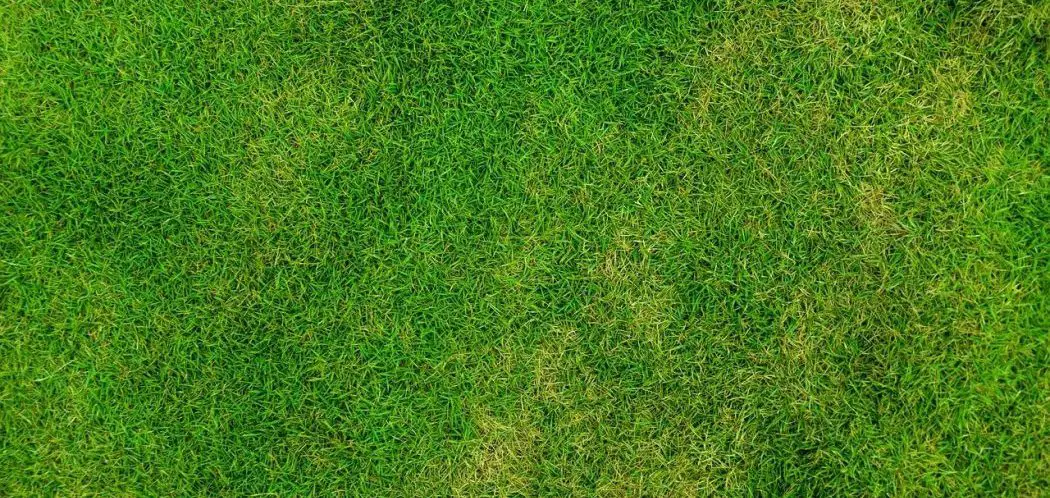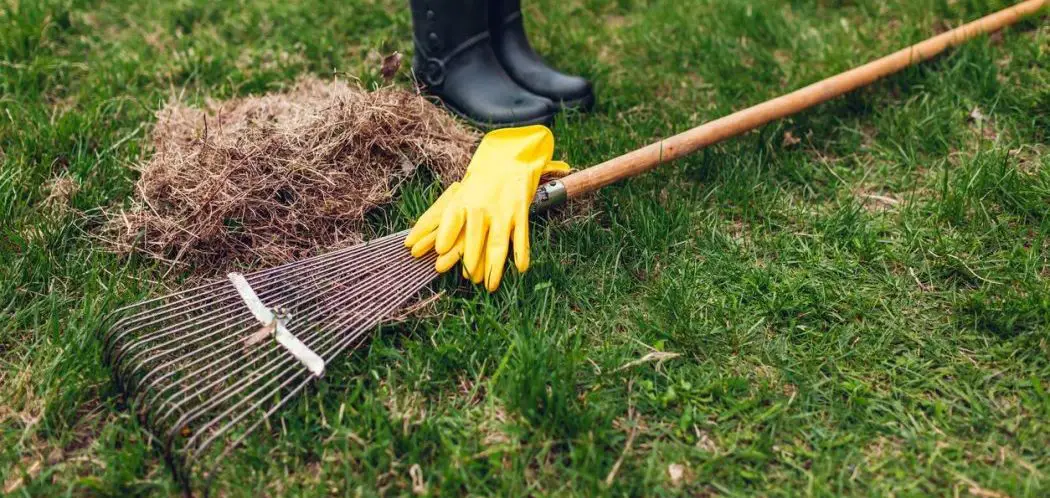Before we get started on how to power rake your lawn, let’s get clear on what a power rake is and what it’s for…
Power Rake vs Aerator – They Are Not the Same!
A lot of people get power rakes and core aerator machines mixed up but they are NOT the same.
A core aerator machine has tines which dig into the ground a pull up plugs of soil called cores.
With an aerator, the aim is to reduce compaction and allow for more air, water and nutrients to get down into the ground and create a better environment for your grass to grow.
The purpose of a power rake is to remove surface debris from your lawn. While these machines can be quite intimidating, they’re actually pretty simple to use.
A power rake may look a little bit like a lawn mower initially.
If you look underneath, you’ll notice it has some flails that spin really fast and score the ground.
The flails aren’t sharp. They are flat disks that are designed to pull up debris out of the grass.
What About Detaching Machines and Rakes?
Power rakes tend to be a lot more aggressive at removing debris than a dethatching machine.
They work great on tougher grass types like bermuda or zoysia, but it can really be effective on any lawn.
The least expensive way to remove any excess debris from your lawn is to us a thatch rake but these can be challenging to use.
Anyone who’s tried to use one of these knows exactly what I’m talking about. It’s really hard work and it takes a lot of time! If you have a small lawn, these are a great tool but if your yard is large, you will almost certainly want help from a machine.
You don’t necessarily have to purchase a power rake…
You can rent one for the day at a reasonable price.
I wouldn’t recommend buying one unless you’re looking after a lot of lawns.
Why You Should Power Rake Your Lawn
Too much surface debris is not a good look…
You might see some variations in the color of your grass where it appears thick and thin.
Some of the brown spots may be where the dead grass is unable to be decomposed by the microbes, so it just ends up sitting in your grass.
Too much surface debris can cause problems with the health of your lawn
It’s really important that you remove this debris in your grass because it slows down oxygen flow and it can leave your lawn vulnerable to snow mold and other fungal diseases.
The water can’t get down deep into the root system. It’s also unable to evaporate which leaving the perfect environment for fungus growth. Too much surface debris could even choke out new rhizome growth and leave you with a shallow root system.
Don’t waste your fertilizer!
Any fertilizer you put down is going to have a tricky time getting through this surface debris layer so you won’t be getting the full benefit.
Surface debris can cause a whole host of problems so it’s something to remove when in builds up too thick.
One you remove all that nasty debris out of your lawn…
You’re left with only the live grass.
This will leave you with a much better-looking lawn, deeper in color. The lawn will be able to take in more nutrition, sunlight and moisture.
Power raking helps the grass from being crowded out by dead debris.
There is something very satisfying about removing all that debris out of your lawn…
How Often Should You Use a Power Rake?
The answer is probably going to come as a bit of a surprise…
In an ideal world, you only need to power rake your lawn every few years although this does depend on a couple of factors.
I don’t recommend using a power rake too often.
It causes a lot of stress on your lawn and so you’ll need to give it several weeks to recover.
Dethatching machines can actually be used much more regularly. These have tines which cause a lot less damage so it’s fine to use every week if you want to.
The Two Most Important Causes of Lawn Debris Build up Are:
Improper Watering
You should be watering deeply and infrequently in order to build a deep root system.
Improper Mulching
If you are mulching correctly, you shouldn’t have an issue with debris build up. Improper mulching can cause a lot of thatch build up fast.
If you leave behind chunks of grass that are too big, they are not going to break down so make sure you have the right mower if you want to mulch.
Having a small layer of debris in your lawn is actually beneficial. It can help to harvest a lot of beneficial bacteria however when it gets too thick, you do need to remove some of it.
Check the Color of the Grass Blades
You’ll know its time to power rake when the grass blades have a nice color, but the green is drowned out by the dead layer living between them.
You will also be able to pull out a significant amount of debris with your fingertips.
Use a Thatch Rake to Test a Small Area
You could also use a thatch rake to find out if you have a lot of debris in your grass. These special tools have two sides to them.
Performing a couple of stokes over just a few square feet can pull up a bunch of matted grass.
If you do have a have a thatch problem, you’ll definitely know about it.
How to Power Rake Your Lawn
Clear up Any Debris in Your Yard Before You Begin
The first thing you need to do is walk around your lawn and pick up any debris like rocks of children’s toys. You’ll also want to locate any sprinkler heads that you need to stay away from.
Think about anything underground that could be damaged too.
Consider things like electrical wiring and underground piping.
Spending just a little bit of time investigating the yard could prevent a very costly accident.
Mow Your Lawn With a Lower Cutting Height
The second thing you’ll want to do is lower your mower and cut the grass to get as much of the debris off that top layer as possible. This prevents the power rake from ripping up the grass when you use it.
Starting the Engine
To start the engine, all you need to do is open the fuel valve, turn the choke to the closed position, flick on the ignition switch and then slowly pull the recoil starter. Once the engine starts you can open up the choke and then you’re good to go!
Make Sure the Height Setting of the Power Rake Is Correct
The next thing you need to do is adjust the height of the power rake which you can do by moving a lever on the side of the machine.
All power rakes will have a transport setting which lifts the deck off the ground and allows to push it around.
Ultimately, the height you want to set will depend on how much debris you have.
The lowest setting will remove more thatch but it could also dig up live grass roots which is not what you want to do. If you go too low, you will end up scalping the lawn.
I recommend starting high and performing a test pass before lowering the height down.
Figuring out the right height can be a little hard if you haven’t used the machine before.
I like to set the height to cover about ½ inch below the surface of the lawn. You could even go slightly lower if you wanted to.
How to Power Rake
Once you have found your optimal height, you can now begin to power rake the rest of your lawn.
I’d recommend raking the edges of your yard first. This will make things easier when you got to do your main passes.
Initially, you should perform passes in one direction, just like you would when mowing the lawn. At the end of each pass, you should pivot the rake on its rear wheels before engaging the rake again.
After you have done the whole area, perform a second lot of passes in the opposite direction. You’ll notice less thatch being pulled from the second lot.
If you do have any slopes in your yard, I’d recommend going across the slope rather than going up and down.
Make sure you go at a nice steady pace!
If you go too slowly, you’ll be tearing up too much of the grass. If you go too fast, the flails won’t have time to properly pull up the debris.
After you have used the power rake in both directions, you may want to spot thatch rake any areas which your power rake can’t get to.
Rake up the Remaining Thatch
After you have gone all over your lawn with the power rake, you’re going to have a lot of debris sitting on top of your grass which you’ll need to pick up.
You’ll probably be surprised at the sheer volume of debris that comes out of your lawn!
You can pick up the dead clippings with a bagging mower, or you can take a standard yard rake and sweep it all up.
After you’ve finished with picking up all the clippings, it’s probably a good idea to clean off the rake with a hose to get out all those nasty clippings.

Enjoy the Fruits of Your Labor!
Hopefully once you have completed the above steps, you’ll notice there is a lot less debris sitting in your lawn.
The main thing you should notice is the color change.
You’re not really ever going to remove all of the thatch from your lawn, and it’s not desirable to do so either. Nethertheless it feels amazing when you see all that junk removed.
I find it’s a lot of fun and very satisfying to do!
FAQ: Can You Power Rake When It’s Hot Outside?
A common question people ask is – can you use a power rake in the summer time when the temperatures are high? There are some conflicting opinions around this topic. Some say that power raking stresses the lawn out too much and should not be done during high heat.
From my perspective, removing this dead debris is always better than leaving it in your grass.
The areas where you have thatch build up is usually always warmer than the rest of the lawn. It retains the ground temperature which can be a huge deal, especially for a cool season grass.
In my opinion, there are always too many reasons to remove surface debris, regardless of the temperature outside.




